BJ Lackland, CEO of Lighter Capital, is joined on the Tactical Theater stage by Leo Widrich, co-founder and COO of Buffer.
In this talk, Leo shares the top 10 lessons that he and the Buffer team have learned from getting to (almost) $10 million in ARR. Among his pieces of advice, he shares how to reap the benefits of storing your company’s data in-house, seek conflicting advice in order to better make decisions, and be more adventurous with your pricing strategies. Don’t let the title fool you, this isn’t the same blah blah “advice” you’ve heard again and again, Leo’s nuggets are tactical and actionable. A don’t-miss session for any growth stage founder. (In case you can’t tell, this is one my fav sessions from 2016.) You can view Leo’s slides here.
If you want to see more sessions from 2016, we’re releasing a new one each week. Subscribe here to be notified. And be sure to grab your tickets to the 2017 Annual NOW.
TRANSCRIPT
BJ Lackland: Welcome back from lunch. I’m BJ Lackland, the CEO of Lighter Capital. I’m really pleased to present today Leo Widrich from Buffer, the Co-Founder and CEO of Buffer.
I’m sure almost everybody here knows Buffer. I have been an active user of Buffer for years. I’m sure everybody here knows a little bit about Buffer, that they have an incredibly transparent culture and are very straightforward.
They also are an entirely distributed team, which might be an interesting thing for lots of you to know. They now have 80 employees spread throughout 40 different cities, and they get together occasionally. In fact, I was telling Leo backstage, I think they really do that so that he can get good trips to Hawaii.
Leo is here to present the “Top 10 Learnings Getting to 10 Million.” I think it’s going to be a really great presentation. I think you’ll really enjoy it, so if everybody can find a seat, we’d like to get going, and welcome Leo out here.
[applause]
Leo Widrich: All right, man. Cool. Hello, everyone. Just put this down here.
It’s so awesome to be here. I remember the last few years that I was following along with SaaStr, there was so many great talks. I watched them on YouTube. I was talking with Jason about it, and I was always like, “Oh, I really want to attend.” The fact that I can come and actually give a talk is a real honor. I’m really pleased to be here.
For context, BJ already gave some great info. Who in the room knows about Buffer? Quick show of hands. Who’s a user of Buffer? The person in back who is slightly unsure, maybe they will turn soon. We can talk later a little bit more about that.
[laughter]
Leo: As a company, we build social media management and social media management tools. We help you schedule. We help you organize all your social accounts, Twitter, Facebook, LinkedIn. We help you schedule posts. We help you collaborate as a team. That’s what we do from the product side of things.
As a company, as BJ mentioned, we are about 75, 80 people. I keep losing track of things. We’ve been going for about five years now, so it’s been around for a little while. We are a company that’s completely remote, as BJ mentioned, across five different continents, over 40 different cities. We just hit 50,000 paying customers a few days ago which I’m really excited about.
[applause]
Leo: From a numbers perspective, when Jason and I, we brainstormed on this talk, we said, “OK, let’s do ‘Top 10 Learnings Going to 10 Million,'” and said, “Oh, we’re not quite at 10.” We’re at about 8.9, so almost 9. We are estimating that we’ll get to 10 by March. That’s why I tried to change the title slightly and go to “almost.”
For today’s talk, I want to give you 10 lessons. I want to help you with some more tactical things. There’s some really great high level stuff going on. What my goal really is across marketing product, general business practices…
I want to really try and dive in so that hopefully most of you in the room will be able to pick one or two of those things up, and tomorrow try and implement some of those things and see if that helps you build a better company.
Let’s dive in. 10 things. Here we go.
This is the first lesson that I want to share, which is my co-founder, Joel, introduced me to an idea of a weekly mastermind with myself. What I find interesting is when we work on our startup is that often times we work on the startup. 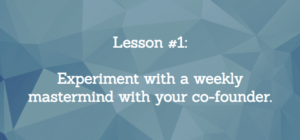
We rarely work on the relationship between our co-founders or between our early team members enough. It was really useful for me that Joel helped me by introducing me to this concept. We’ve been doing this for the last five years, once a week. It’s totally transformed my relationship with my co-founders.
This idea of actually working on the relationship with your co-founder, or with your other team members, as well as on the company, I think is quite counter intuitive, especially early on. I see a lot of startup founders that come to me.
It’s like we know each other so well. “I work with this guy. I work with this girl all day. We know everything about each other.” I think that’s a really easy trap to fall into, that we’ve fallen into, where if you don’t zoom out, a lot of things can sort of build up.
This is how this works. This is what Joel and I do. The first thing is we try and take about one or two hours where we try and find a time that’s slightly less busy. On a Friday evening, on an off day, on a Sunday, we try to get together in a coffee shop, in a really casual setting.
We take 10 minutes, and we talk about each other’s achievements. What I love about this point is that oftentimes, especially early on when we were building our businesses, we don’t take enough time to reflect on these things that we have accomplished. We always think about what else we want to do, what else we can get to.
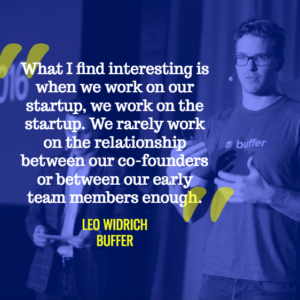 I think this can be really powerful to avoid burning out, and actually say, “Hey. I know, everything is falling apart. At the same time here are some things that I’m actually proud of, that are actually going well.” I think that achievement section has helped my personal happiness a lot throughout the years.
I think this can be really powerful to avoid burning out, and actually say, “Hey. I know, everything is falling apart. At the same time here are some things that I’m actually proud of, that are actually going well.” I think that achievement section has helped my personal happiness a lot throughout the years.
Then we move on to challenges. We talk about each other’s challenges. We talk about personal challenges. We talk about business challenges. This is really a session to get really deep into some topics.
The one tip here, if you experiment with that, is to avoid solving each other’s problems. Instead, really practice listening, and the Socratic method, which is to ask more questions and to really let that person come up with their own solution instead of you trying to be, “Oh, yeah, you should do this.”
Lastly, we have a section about feedback for each other. Again, when you’ve been in the day to day, when you’re so zoomed in, when you stop actually sometimes zooming out and talking about some of the things that bothered you. I think can be really useful to have that.
Point number two, something really powerful, and there’s a lot of sessions today around data, how to use data. In general, I think there is so much that we learn on a day to day basis, how to use data.
I actually believe that it can be such a huge distraction early on, when you’re building your company, where you get too focused, to narrowed in trying to look at charts or look at numbers when it can actually be much more useful to focus on the more qualitative stuff instead. 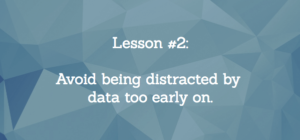
I have this quote from Heaton, he spoke here earlier, which I really love. He talks about the importance of actually using more qualitative data and not relying on quantitative data. What I love about this quote is actually that Heaton said it, because Heaton is a guy who sells you analytics software.
If a guy who sells you analytic software tells you to not use analytics and data that much early on, I find that double encouraging. If you can try and take a step back, especially early on, when you don’t have what Heaton talks about here, thousands or hundreds of new customers every month, to really focus more on the qualitative insights.
I think that’s such a big recommendation that I want to make, and that’s actually my next point of how you can do that better. This is about learning to talk with customers. What I find oftentimes, when I talk with some founders and early stage companies, we have a lot of core functions in the business.
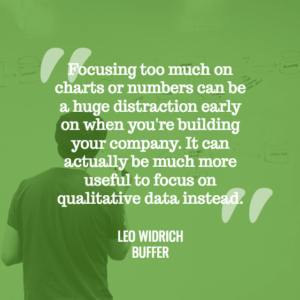 We all know about marketing. We know about product. We know about sales, and we know about customer service. So we know that’s when we talk with customers, and what’s interesting is that whenever we do have those things, none of those four things usually touches on simply sitting down and talking with a customer about their problems.
We all know about marketing. We know about product. We know about sales, and we know about customer service. So we know that’s when we talk with customers, and what’s interesting is that whenever we do have those things, none of those four things usually touches on simply sitting down and talking with a customer about their problems.
That’s what I think customer development, even though there’s so much written about it, I think it’s still not quite incorporated enough. I hope these five questions can be potentially useful to people to try out.
They come from a book called Lean Customer Development by Cindy Alvarez. I can highly recommend getting this book, because there’s way more in that book beyond those five questions, which are also from the book, that just really teach you on a fundamental basis how you should talk with customers.
I think it’s we oftentimes, again, have this assumption. It was certainly true for myself. “I know how to talk with customers,” when really, there’s so much to be learned and improved.
These are the five questions. There is one thing, when you read through those, that I think is really interesting, where you won’t find any, what in customer development, we call leading questions. You won’t find any questions here that are, “Would you buy this if…?” or, “Would you use this?”, these questions that bias the person already to say yes which we really want to avoid.
The one particular one that I want to highlight here is the magic wand question. That’s one of my favorite questions. What I’ve found is that everyone loves to be a magician every so often, and to really try and think about, “What is even possible with this product?” 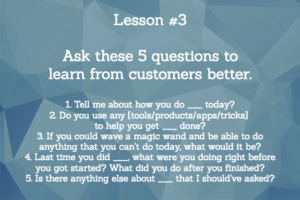
It can feel slightly embarrassing if you feel like, “Oh, but I don’t want to…”, like, “It’s a professional setting.I don’t want to give…” Would you use a magic wand? What will you do? I found this really, really powerful to actually use some creativity from the customers you’re talking to.
I want to make one more final point on the data. Avoid being distracted by data early on, trying to use these questions, but then also as your company grows, as you hit that point that Heaton talked about, when you actually get to the hundreds or thousands of customers every month, then one thing we’ve learned about data at Buffer is to try and keep the data in-house.
This is Buffer’s quick journey with data. So from 2010 to 2011, everything was in-house, and Joel built those tools early on. 2012, we experimented with various third party tools, KISSmetrics, Mixpanel. We moved back to building our own tools.
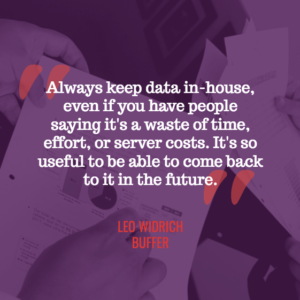 Now we transitioned last year, again, to another tool called Looker. I think they even have a booth out there. Throughout this roller coaster ride of using different data tools and really trying to learn how to best make use of our data, the one lesson that we’ve learned, frankly, in a very hard way, is that you always want to keep at least one copy of your data in-house.
Now we transitioned last year, again, to another tool called Looker. I think they even have a booth out there. Throughout this roller coaster ride of using different data tools and really trying to learn how to best make use of our data, the one lesson that we’ve learned, frankly, in a very hard way, is that you always want to keep at least one copy of your data in-house.
There is a lot of people in a company that sometimes will walk up to you and say, “You shouldn’t do that.” There will be some engineers that come to you and say, “We’re already sending this data to this tool, we don’t need to store that,” or, “We don’t want to hog our servers with this data, because we want to have real time data here.”
But in our case, that really was biting us in the ass, at the point where we were not able to make certain decisions anymore, because we didn’t have all the data in-house. No tool that you ever use out there, ever, is going to be an analytics or software tool for your particular business. 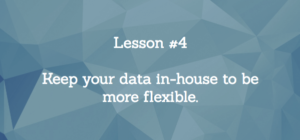
We’re all here in this room because we’re trying to grow our companies and make it scale, and make it fit multiple use cases, whereas your company, there’s only one like it. Therefore, I just want to give you this one lesson from us that we learned, keeping that always in-house, even if you have people saying it’s a waste of time, a waste of effort, a waste of server costs, it’s so useful to, at some point, come back to that.
This next one is a really interesting one about marketing, and I think it’s quite counterintuitive. I had a discussion earlier on with some people about this, from my friends at Feedly and the founder there. We talked about this from the perspective, “If you go and do marketing, should you pick one channel? If so, how, and why, and how do you get there?”
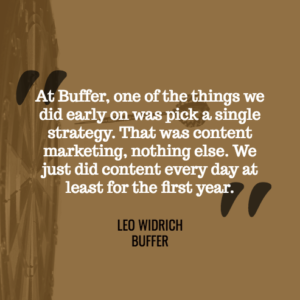 I see a lot of this idea around spray and pray. You’re an early startup, you’re just like, “Let me go and just see what sticks. Let me try every marketing strategy in the world, and see what works out for us, and then I’ll keep some of them around.”
I see a lot of this idea around spray and pray. You’re an early startup, you’re just like, “Let me go and just see what sticks. Let me try every marketing strategy in the world, and see what works out for us, and then I’ll keep some of them around.”
I think that can be quite less than ideal, in many cases. At Buffer, one of the things we’ve done early on, we picked a single strategy only. That was content marketing, nothing else. No paid, no SEO, no nothing. We just did content, content every day, at least for the first year.
Over time, of course you branch out, but looking back, that was one of the, in hindsight, very, very good decisions that we made, because it kept us so focused and so on track. There’s this exercise called the bullseye exercise. It comes from a book by Gabriel Weinberg called Traction.
I can highly recommend that book, by the way. Again, it’s super, super useful. Gabriel talks about these three steps to finding your one channel. The first one he talks about is the outer ring of the bullseye. He identified 19 different channels. You’re not trying to try and go after all those 19, but you want to write them down, and at least brainstorm on them. 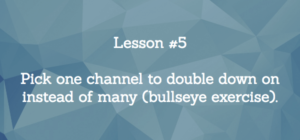
Then he says, “Pick three or four that you think are most promising, either from early data that you already have, and try and run some cheap tests.” For about three to four weeks, run some tests, see what works.
Then he says, “OK, finally pick one, and really be disciplined with yourself and not say, ‘Well, you’re kind of getting a little help from SEO, and a little bit from paid, so we’re going to do both a little bit. Be really disciplined with yourself, and pick one.”
There’s three reasons why I think it’s so important to be disciplined with that. The first one is what we call the marketing flywheel. It’s this idea that, when you start working with just one channel, you create this early repeatability, which really helps you to create this momentum, and build sliver after sliver, that then eventually turns into the curve that we all want.
The second idea, here is, with early repeatability, what you really want is to become good at marketing. If you pick two, or even three different channels, you just don’t build up the expertise early on, you spread yourself too thin.
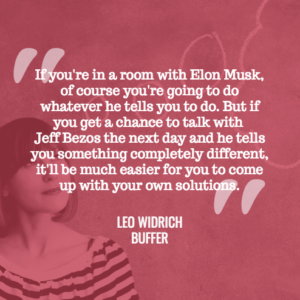 At Buffer, for example, we have so much to learn with content, there’s so much further for us to go, but we feel so much more comfortable, because we’ve doubled down on it so much. We feel our expertise there is so much stronger.
At Buffer, for example, we have so much to learn with content, there’s so much further for us to go, but we feel so much more comfortable, because we’ve doubled down on it so much. We feel our expertise there is so much stronger.
The other idea of the marketing flywheel is that you can actually step away. Right now, at Buffer, we could step away, stop doing content for a while, and we would still reap those benefits that are going on, even if you don’t keep doing it.
This next one is a really, really difficult one for me, personally. That’s almost like advice for myself. [laughs] I don’t know if everyone feels that way, but here’s how I operate. I listen to someone that I’m inspired by, and I’m hooked. I’m like, “OK, I’m going to do exactly what…This guy is successful, this guy has done this before. I’m going to go exactly after what this guy has just told me.”
I think one of the lessons I’ve learned is that that can be really counterproductive to building an excellent, real, authentic business where you’re creating your own path along the way. One lesson I’ve learned is that now every time there’s the big decision, “Should you raise funding, how much should you raise, should you hire that person, that VP of sales? Is it too late, is it too early?” 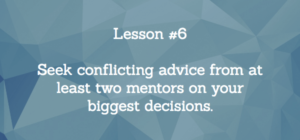
Whenever you have those big conversations, try and get two opposing opinions that you really respect. In the past, I would talk with someone, and be so hooked. Now my immediate goal is after I’ve had one of those conversations, is to immediately go and talk with someone who I know will disagree with that.
That leaves me with the idea that now I’ve heard two exact, opposing opinions from people that I respect, and I’m forced to make up my own mind. I think that’s such a powerful position to be in, to really keep you empowered as a founder, not to just copy and paste.
We all know the persuasiveness that authorities have. If you’re in a room with Elon Musk, of course you’re going to do whatever he tells you to do, but if you get a chance to then talk with Jeff Bezos the next day, and he tells you something completely different, you’ll be much more easily able to come up with your own solutions.
This is another one that’s a lesson for Buffer, that we want to do better ourselves, which is to really be much more adventurous when it comes to changing our pricing. I feel like oftentimes, we’re so zoomed in, we’re building great features for our product, we neglect how much more value we’re building.
That value can actually be translated into a higher price point. I think it’s one of the most neglected, but most powerful changes you can make at your company. 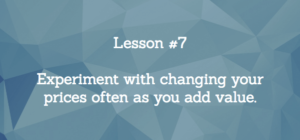
Another problem that I’ve seen with making pricing changes is that we have a huge barrier in our heads. We feel like there will be huge backlash from all our customers, or if we change our pricing, no one will start wanting to pay us anymore.
We have all these things in our heads that make us like, “OK, let’s not touch this pricing page,” anywhere near enough, as much as we should. I want to give you some real data of some of the things we’ve done at Buffer.
We have done many pricing changes. Again, we actually haven’t changed our pricing again for a while now. We’re in the middle right now of experimenting with that again.
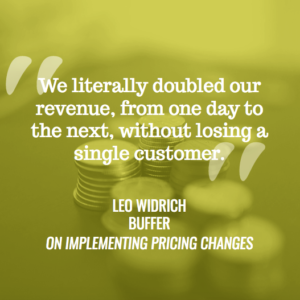 We went from this $5, $20, and free, to free and $10, in the business plan, in the enterprise plan now. When we switched from the $5 to the $10, we had zero change in conversion rate. We literally doubled our revenue, from one day to the next, without losing a single customer.
We went from this $5, $20, and free, to free and $10, in the business plan, in the enterprise plan now. When we switched from the $5 to the $10, we had zero change in conversion rate. We literally doubled our revenue, from one day to the next, without losing a single customer.
That’s just so fascinating for me to be like, “All these days when we were were worrying that no one will start paying us anymore,” but we were building all this value to add to our product. That was just really eye opening for me. Really working with our own buyers has helped us a lot.
This is a very strange phenomenon, I see going on at startups. I feel like I’m bringing up Heaton a lot, but he’s a big mentor, an investor, and advisor at Buffer, and we’ve had some great conversations.
Heaton actually called this…I don’t know what he said. It’s like a law or something. The law, let’s call it Heaton’s Law. It goes something like, “Startups use the lean startup methodology once, and then never again.” 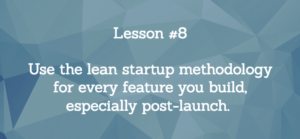
That was certainly true for us at Buffer, and honestly, I don’t know why. Sometimes at Buffer, we feel like we have been disciplined at starting and launching our product with the lean startup, creating a hypotheses, and not building, but actually talking to consumers.
Then after a while, we’re getting some traction. Maybe that’s when we get some traction, and we’re like, “Now we know what to build. Now we can just go and build features, and we know what’s next, and it’s kind of obvious.” We stopped being disciplined, and at Buffer, that created a lot of waste.
We had a period of time of almost a year, where we just ended up building features, even though in the very first iteration, we were very disciplined, where we stopped using the lean startup methodology.
This was really what helped us get our startup mojo back, is what I like to say, which was when we built a new product line, it’s called Buffer for Business, we started to be able to be very disciplined again. What you are seeing on the screen here is the actual pricing page of the first version.
This is literally a Wufoo form, which was the first pricing page. People would select which plan they would put their email in, submit the form, and we’d reach out for them. This was super, super lean, at this stage.
We really went back to interviewing customers, building MVPs, and then doing all the things we all know in this room, or many of you all know, about the lean startup, and really being disciplined about it. Buffer for Business is now doing 45 percent of Buffer’s total revenue, and so this has been really successful for us, to take that approach here.
This is what we started to do. We’ve really started to create a process around it. We said, “No more. We don’t want to keep falling into this trap of building things. Let’s really institutionalize this. How are we going to do it?”
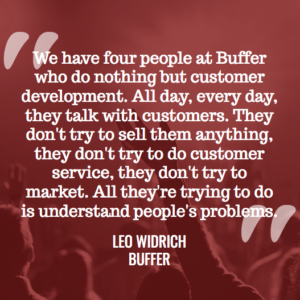 For context, we talked about the customer development earlier. We have four people, full time, at Buffer now who do nothing but customer development. All day, every day, they talk with customers. They don’t try to sell them anything, they don’t try to do customer service, they don’t try to market. All they’re trying to do is understand people’s problems.
For context, we talked about the customer development earlier. We have four people, full time, at Buffer now who do nothing but customer development. All day, every day, they talk with customers. They don’t try to sell them anything, they don’t try to do customer service, they don’t try to market. All they’re trying to do is understand people’s problems.
I think this methodology has really helped us. We want to have a hypothesis for every feature that you’re building, something that, by definition therefore, can be invalidated. After you go into a customer development phase, it can happen that you stop building this feature, but if you’ve realized your hypotheses were wrong.
This next step for us, again, in this new process of being diligent and more disciplined is, we love InVision, to create clickable prototypes. It’s a great product, many of you have probably heard about it, for design. It helps us to get feedback. Again, we’re at the third stage of building a new feature, or a new product, and we still haven’t written a line of code.
The fourth version is roll out a version that you’re slightly embarrassed by, of the first feature. I think this line, this famous quote from Reed Hoffman around, “You should be embarrassed by your first version.”
I think that also gets misinterpreted a lot, because you shouldn’t be embarrassed by it. If it completely breaks, and it’s completely unusable, that’s the wrong type of embarrassment you want.
I think the type of embarrassment that’s good is embarrassment of richness. You’re embarrassed because it’s only this one feature, and you wish you had done three more, but that’s really the type of embarrassment you want, where it’s complete, in itself.
We often talk about, it should be not the base layer of a cake, but it should be a cupcake. A cupcake, in itself, is complete. I think that’s really what you want, when you’re slightly embarrassed with the version that you didn’t roll out.
Number nine, this is really interesting for me, personally. I feel like that almost gets me, to a spiritual level, whenever we did get offers to sell Buffer. Throughout the five years of Buffer’s journey, we had four offers, serious offers to sell the company. 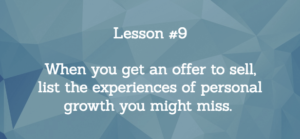
Every stage was really, really difficult for us, to really figure out whether this was the right thing for us, or not. Often times, we talk about selling our companies. We think about, “How much money would I make now,” versus, “How much money would I make if I keep going, and I don’t sell right now?”
One thing that’s really helped us at Buffer is, we did a list that talks about, “What are the experiences we would be missing out on if we were to sell now?” That change of focusing on personal growth, like Einstein’s idea of becoming a person of value, I think is really what helped us navigate those decisions better, if some of you are experiencing some of those moments.
These are actual things that we listed, when we got offers to sell. We listed what we wouldn’t learn, and we wrote down, “We wouldn’t learn how to scale to tens of thousands of customers, how to let someone go, how to acquire another company,” which we have now done a few months ago. We wouldn’t learn how to recover from a hack.
The reason I think all these things are interesting is that we want to be people that are able to offer some of those experiences to other people when they come and call us. I want to be the guy like, “Let me call Leo. He’s been through a hack, he knows how to let someone go. He’s been through this.”
That’s, for me, the aspiration of, “Who do I want to be from a personal growth perspective,” that goes beyond, “OK, how much money do I have in my pocket?” Even though financial reward is still something I am interested in, but at the same time, this helped me frame the question a little bit better.
This quote from Darmesh, one of our awesome advisors, and investors as well, was something that helped me with that. He said, “Stop thinking about making a million dollars. Start thinking about serving a million people.” The same idea, the same framework, and it’s been really, really powerful for us.
The 10th lesson, I actually left open, because we’re not quite at 10 million, so I thought it would be unfair to have 10 lessons. What I do want to do, if you go to open buffer.com, you can drop in your email, and as soon as we hit 10 million, I’m going to have a 10th lesson for you. 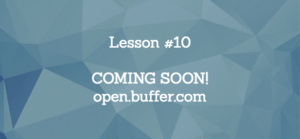
[laughter]
Leo: It’s just going to be slightly delayed, so I’m scheduling that one out into the future. We have some experience with that.
That’s really it. Thanks so much. We do a lot of things, like BJ mentioned, that are very transparent, so if you go to buffer.com/transparency, that’s how a lot of people learn from us, which I’m really, really grateful for, if that’s useful for you. We have transparent revenue, transparent pricing, transparent equity, transparent salaries, everything on there.
If you want to talk with me more one on one, it’s leo@buffer.com, or hit me up on Twitter, Instagram, @LeoWid. Thanks so much everyone, this was really fun.
[applause]
BJ: We’ve got a little bit more time for some questions, a couple of minutes here. If people want to raise hands and ask a couple questions. That was great, Leo. It was an awesome 10 lessons, or 9 plus.
[laughter]
BJ: Anyone? We’ve got one over here.
Patik: Hi. I’m Patik, and I’m from India. I’ve come here to learn more about SaaS. Indian companies are also building a lot of products now.
One question I had regarding companies like Buffer, that start off solving a very specific need for, you could say a niche segment, is when you look at companies, normally like consumer companies or otherwise, you think about entry barriers, you think about switching costs, and a lot of those things, which are not really clear in pure-play SaaS products.
A lot of people can hypothetically build something very similar, so how do you think about growing this? Is there something on your mind? What do you think about, to mitigate such risks? Do you even think that’s a big risk?
Leo: I guess it also comes into competition, and the other companies. It’s really interesting. I can never know, because we are so oblivious to competition at Buffer, whether we are ignorant, or whether we are arrogant, or whether we are naïve, or some combination of some of those three things.
Truthfully, it’s never on my mind. I never think about it. There’s other great players in our space that we really respect. For us, we have such a focus on our customers. We’re going to build features that are great for them. We want to do great marketing, to reach new people.
I am so focused on just providing value to people, that it’s a huge distraction for us to think of, “Oh, what if they don’t like this?” You can fix all those problems by actually focusing on your own customers. I know it’s kind of a non answer, but I don’t spend a lot of time thinking about that.
It takes some practice. You’re always like, “Oh, they’re building this,” or, “Our competitors are going to eat us.” I think, working through that, it can actually be more useful than trying to do something that’s not focused on your own customers.
BJ: You guys are so strong in content marketing, too, that it probably helps keep away the competition a bit. Maybe we have time for one more. Yes, over here? Or no.
Audience Member: All right, thank you. I’m very interested to know, I think you guys already did two acquisitions. I’d like to know whether there was a strategy behind that, because let’s say you’re pre $10 million revenue.
Was it for buying a team, was it for a client, was it for product? What were all the strategies behind those two acquisitions, and what was the value out of them?
Leo: The value for us, with the acquisition that we’ve made was that, for a while Buffer’s in the publishing space, we help you publish to social, we help you analyze, we help you be very marketing focused.
We got a lot of feedback from our customers that said, “Hey, we really want you to build a tool for engagement. We want to reply to tweets, we want to reply on Facebook.”
It’s really, again, very customer-driven. We always said, “We might get around to building that. We want to build that in the future,” but it’s like, “We don’t want to spread ourselves too thin.”
When the opportunity came along with Respond, and they were interested in moving on, we always had this in the back of our minds. We built a simple model. You can even Google that, we made some of that transparent.
We made a model that said, “OK, how much would it cost us to build this product versus, how much would it cost us if we’d buy it right now?” The numbers worked out, and so we felt like this was a space we want to move into, and we ran the numbers, and we created the model, and we moved ahead with it.
We tried to be as rational as we could, instead of, “Oh, let’s just jump into this,” but this was always something on our minds. This is something we’ve heard a lot from customers, this is very customer-driven.
BJ: All right, I think we’re out of time. Listen, Leo, thanks so much. This was great. Awesome.
[applause]
Leo: Yeah, thank you.
BJ: Classic to the Buffer culture, very open with some great lessons.
See Leo’s slides here.
